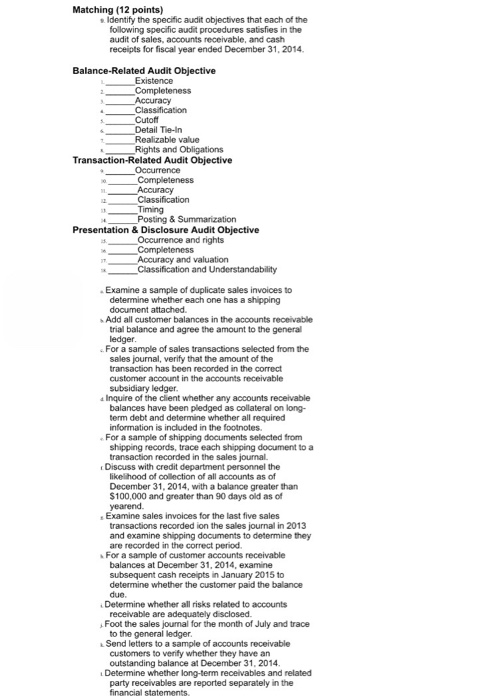Answer 4-18

Identify the specific audit objectives that each of the following specific audit procedures satisfies in the audit of sales, accounts receivable, and cash receipts for fiscal year ended December 31. 2014 Balance-Related Audit Objective Existence Completeness Accuracy Classification Cutoff Detail Tie-ln Realizable value Rights and Obligations Transaction-Related Audit Objective Occurrence Completeness Accuracy Classification Timing Posting & Summarization Presentation & Disclosure Audit Objective Occurrence and rights Completeness Accuracy and valuation Classification and Understandability Examine a sample of duplicate sales invoices to determine whether each one has a shipping document attached. Add all customer balances in the accounts receivable trial balance and agree the amount to the general ledger. For a sample of sales transactions selected from the sales journal, verify that the amount of the transaction has been recorded in the correct customer account in the accounts receivable subsidiary ledger. Inquire of the client whether any accounts receivable balances have been pledged as collateral on long-term debt and determine whether all required information is included in the footnotes. For a sample of shipping documents selected from shipping records, trace each shipping document to a transaction recorded in the sales journal Discuss with credit department personnel the likelihood of collection of all accounts as of December 31, 2014, with a balance greater than $100,000 and greater than 90 days old as of yearend. Examine sales invoices for the last five sales transactions recorded ion the sales journal in 2013 and examine shipping documents to determine they are recorded in the correct period. For a sample of customer accounts receivable balances at December 31, 2014, examine subsequent cash receipts in January 2015 to determine whether the customer paid the balance due. Determine whether all risks related to accounts receivable are adequately disclosed. Foot the sales journal for the month of July and trace to the general ledger. Send letters to a sample of accounts receivable customers to verify whether they have an outstanding balance at December 31, 2014. Determine whether long-term receivables and related party receivables are reported separately in the financial statements. Identify the specific audit objectives that each of the following specific audit procedures satisfies in the audit of sales, accounts receivable, and cash receipts for fiscal year ended December 31. 2014 Balance-Related Audit Objective Existence Completeness Accuracy Classification Cutoff Detail Tie-ln Realizable value Rights and Obligations Transaction-Related Audit Objective Occurrence Completeness Accuracy Classification Timing Posting & Summarization Presentation & Disclosure Audit Objective Occurrence and rights Completeness Accuracy and valuation Classification and Understandability Examine a sample of duplicate sales invoices to determine whether each one has a shipping document attached. Add all customer balances in the accounts receivable trial balance and agree the amount to the general ledger. For a sample of sales transactions selected from the sales journal, verify that the amount of the transaction has been recorded in the correct customer account in the accounts receivable subsidiary ledger. Inquire of the client whether any accounts receivable balances have been pledged as collateral on long-term debt and determine whether all required information is included in the footnotes. For a sample of shipping documents selected from shipping records, trace each shipping document to a transaction recorded in the sales journal Discuss with credit department personnel the likelihood of collection of all accounts as of December 31, 2014, with a balance greater than $100,000 and greater than 90 days old as of yearend. Examine sales invoices for the last five sales transactions recorded ion the sales journal in 2013 and examine shipping documents to determine they are recorded in the correct period. For a sample of customer accounts receivable balances at December 31, 2014, examine subsequent cash receipts in January 2015 to determine whether the customer paid the balance due. Determine whether all risks related to accounts receivable are adequately disclosed. Foot the sales journal for the month of July and trace to the general ledger. Send letters to a sample of accounts receivable customers to verify whether they have an outstanding balance at December 31, 2014. Determine whether long-term receivables and related party receivables are reported separately in the financial statements








